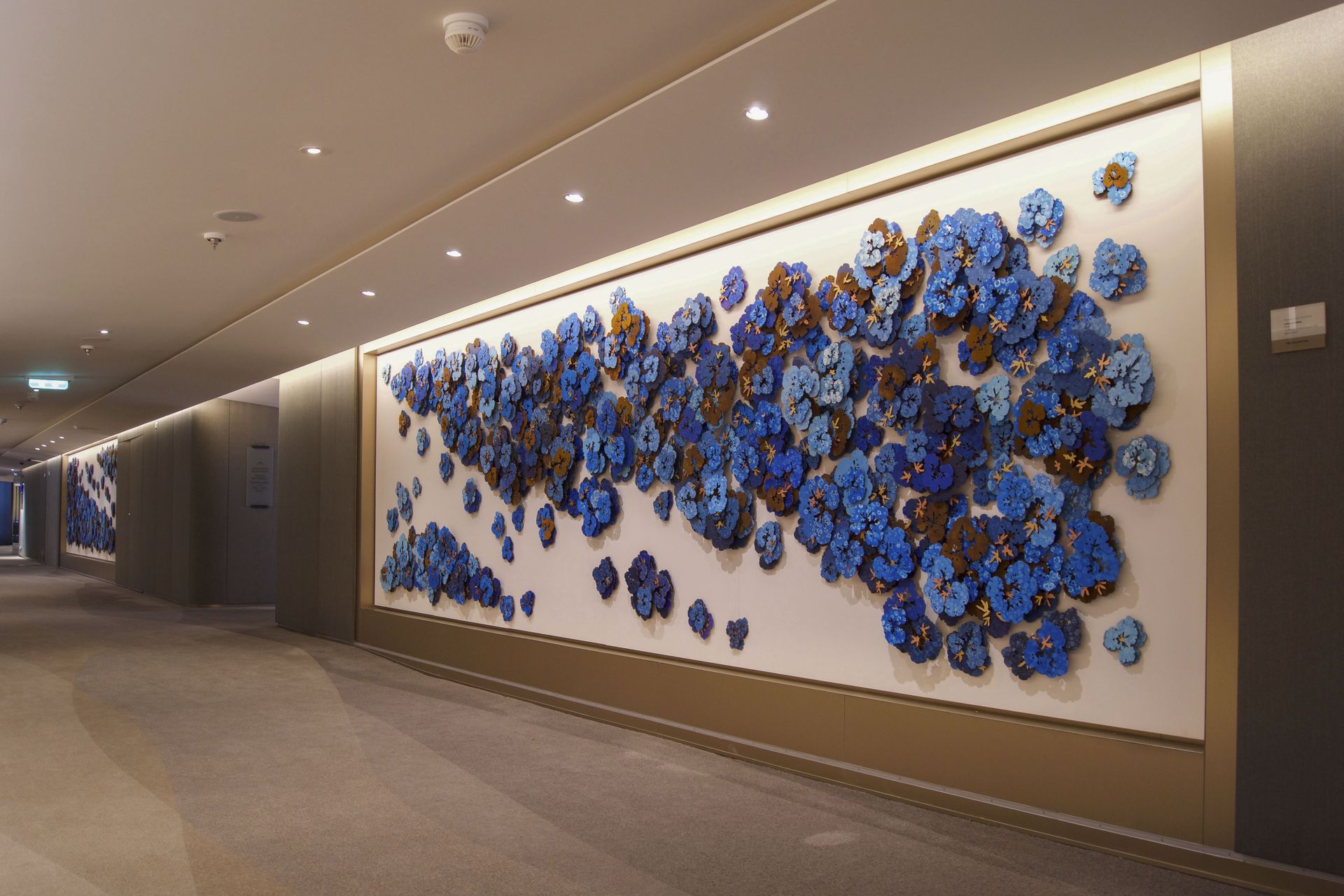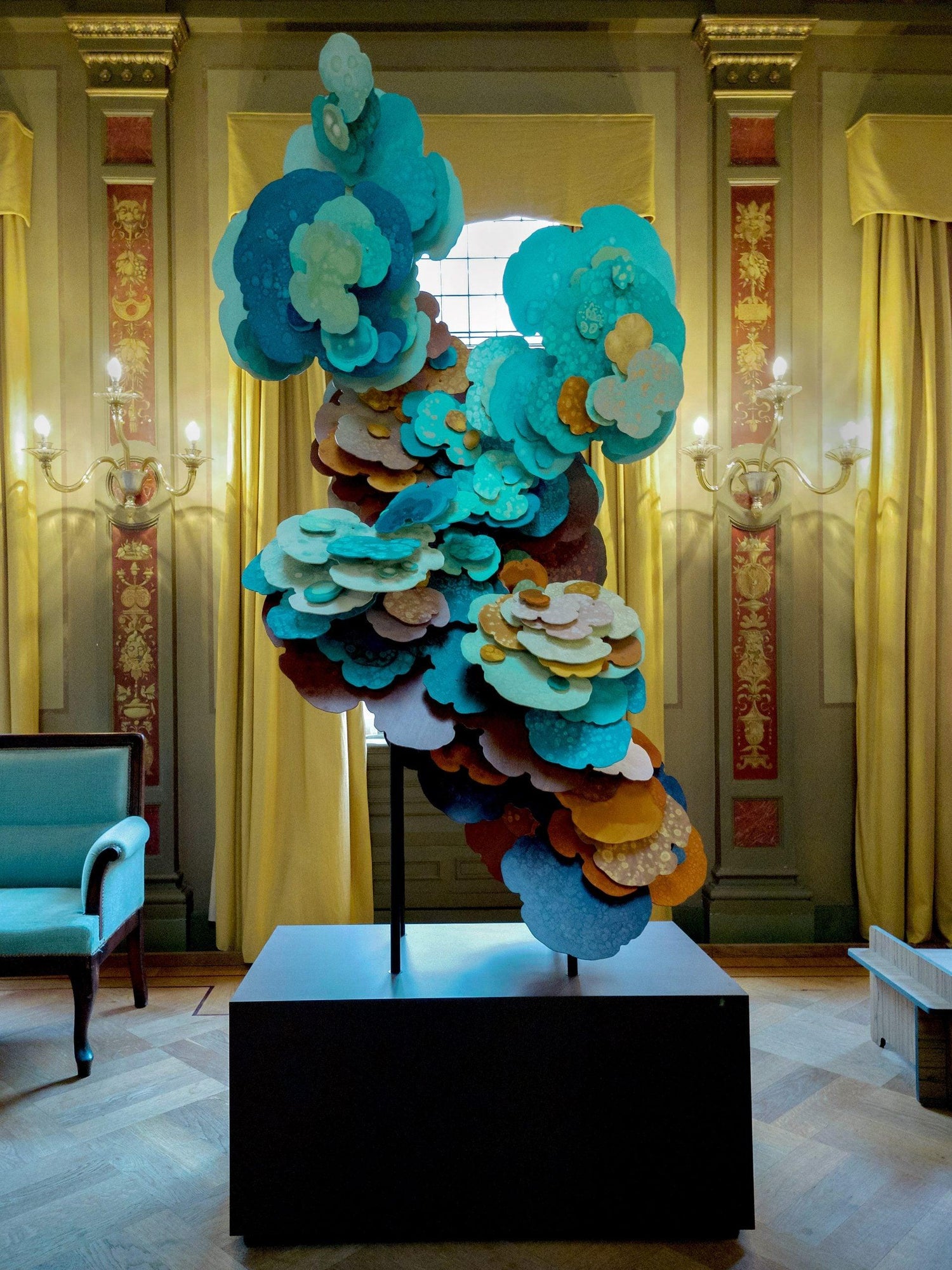Loyal Snijlab customer Joris Kuipers is going to exhibit at OBJECT 2023, and for the occasion we asked him a few questions.

Left: BERM wearable, Joris Kuipers. Right: in the studio with Joris Kuipers
"Snijlab has now been taking care of my cutting for 6 years because the cutting quality is very good: the machines cut in such a way that there is little soot on the sides, and little deposit on the top." - Joris Kuipers
Joris Kuipers is a visual artist; his sculptural oeuvre consists largely of explosive flower-like forms. With flat abstract forms, he puts together impressive spatial creations. Kuipers has these forms cut out at Snijlab.
In 2016, Kuipers first had parts laser-cut at Snijlab for his wall sculpture Multiple. Before this, he cut out his parts independently at a college's Fablab. But this laser cutter was no longer large enough and, in addition, the cutting edges cut at the Fablab gave off a lot of soot.
Laser cutting is the burning or pulverizing of material with a bundled beam of light, in a controlled and very precise manner. Because of this, laser cutting wood will always produce some degree of soot on the cutting edges. But with the right settings and a good machine, soot on cut edges can be minimized very well. In a large print run with many erratic shapes, minimizing soot deposits can quickly save many hours of post-processing.
Joris, we have been cutting out the shapes for your artwork for years. But can you tell us how you make these impressive shapes?
Kuipers: I start with a digital sketch I make on an iPad, which I then convert to a styrofoam maquette. Recently, I also started making scale models in Blender, because I can easily import my Illustrator drawings into it. This is how I create my design.
I always first draw the shapes that are going to be cut out analogously at full size before I digitize them. This preserves the whimsicality of my handwriting.
At Snijlab, I supply painted and varnished plates. You then coat these plates with a protective film so that there is no soot deposit on the top and bottom of the plates during laser cutting. I always pick up and deliver my orders by bike, my studio is around the corner.
Once I receive the laser cut shapes I finish the edges, leaving the protective film in place. When the edges are finished in the right color I remove the protective film and mount the parts together with threaded rods that I developed especially for this purpose.
How interesting to hear how you proceed. Do you use other techniques besides laser cutting?
Kuipers: You can think of my wall sculptures as spatial paintings. I use a self-developed painting technique, which could be compared to Faux Peinture, without literally depicting a material (like marble).
For this I use birch plywood panels, I coat them with a few layers of transparent acrylic paint. To get a spotty texture in the paint layer I then work them with different mediums, this gives more depth to the shapes.
Can you name an example of a small and of a large work you have created?
Kuipers: The smallest work is currently 5 cm: a wearable based on the shapes from the wall sculpture BERM, which is being presented at OBJECT Rotterdam 2023.
In 2019, I created a wall relief totaling 12 meters for Royal Caribbean Cruises for one of their ships.

Nocturnal Garden I & II, Joris Kuipers
To achieve the best results for Joris, we regularly conduct cutting tests with different paints and finishes, such as boards worked with acrylic paint and high-gloss varnish, or wood plated with gold leaf. With each of these finishes, we looked for the best setting to minimize soot and tarnish.
What do you think of the collaboration with Snijlab?
Kuipers: The Snijlab team is solution-oriented and thoughtful about different production ways. I have always found the team to be very customer-friendly; both at the counter and via email, all your questions are answered quickly and competently.
The Snijlab website is clear, and ordering is easy because you don't have to wait for someone to prepare a quote for you. You can independently calculate prices and order online, so you can see immediately what the cost of a production is going to be. There is an option to have your work produced quickly or you can wait a little longer for it, which is more economical. This allows you to weigh what is important for your project at that moment.
In addition, Snijlab is within biking distance of my workshop. This makes bringing and picking up my materials very easy, I never have to wait for a mail carrier.
What will you be working on in the coming year?
Kuipers: I am currently putting the finishing touches on BERM, a modular wall sculpture. This will be on display during OBJECT Rotterdam, curated by Anne van der Zwaag. It will then be expanded for a presentation during the Salone de Mobile in Milan. The work will be shown by Masterly, the Dutch in Milano, curated by Nicole Uniquole.
After these exhibitions I will work on a series of 3 multiples. A small, medium and larger sculpture, which together make a wall-filling sculpture.
Thank you Joris, we look forward to admiring your work at Object.
Read more about laser cutting wood here.
Do you have a project with a more challenging material in mind? Then read more about the possibilities here or contact us via info@snijlab.nl or +31 10 3070 949.
* Self supplied material we will always need to test before we can accept an order.

















































